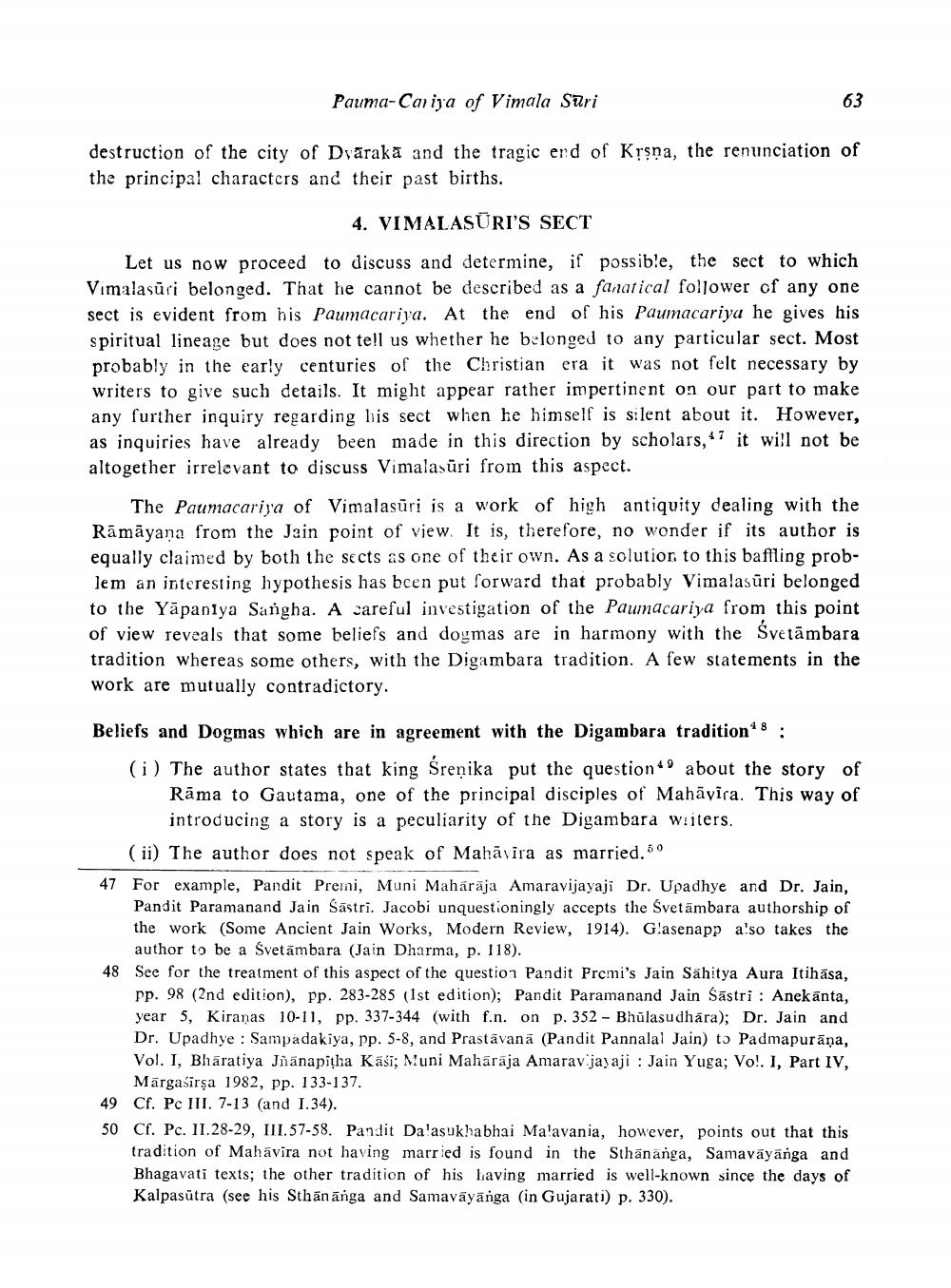________________
Pauma-Cariya of Vimala Suri
destruction of the city of Dvaraka and the tragic end of Krsna, the renunciation of the principal characters and their past births.
63
4. VIMALASURI'S SECT
Let us now proceed to discuss and determine, if possible, the sect to which Vimalasuri belonged. That he cannot be described as a fanatical follower of any one. sect is evident from his Paumacariya. At the end of his Paumacariya he gives his spiritual lineage but does not tell us whether he belonged to any particular sect. Most probably in the early centuries of the Christian era it was not felt necessary by writers to give such details. It might appear rather impertinent on our part to make any further inquiry regarding his sect when he himself is silent about it. However, as inquiries have already been made in this direction by scholars, it will not be altogether irrelevant to discuss Vimalasûri from this aspect.
The Paumacariya of Vimalasüri is a work of high antiquity dealing with the Rāmāyaṇa from the Jain point of view. It is, therefore, no wonder if its author ist equally claimed by both the sects as one of their own. As a solution to this baffling problem an interesting hypothesis has been put forward that probably Vimalasûri belonged to the Yapantya Sangha. A careful investigation of the Paumacariya from this point of view reveals that some beliefs and dogmas are in harmony with the Svetämbara tradition whereas some others, with the Digambara tradition. A few statements in the work are mutually contradictory.
Beliefs and Dogmas which are in agreement with the Digambara tradition* :
(i) The author states that king Śrenika put the question
about the story of Rama to Gautama, one of the principal disciples of Mahavira. This way of introducing a story is a peculiarity of the Digambara wiiters.
(ii) The author does not speak of Mahavira as married.50
47 For example, Pandit Premi, Muni Mahārāja Amaravijayaji Dr. Upadhye and Dr. Jain, Pandit Paramanand Jain Sastri. Jacobi unquestioningly accepts the Svet ämbara authorship of the work (Some Ancient Jain Works, Modern Review, 1914). Glasenapp also takes the author to be a Svetambara (Jain Dharma, p. 118).
48 See for the treatment of this aspect of the question Pandit Premi's Jain Sahitya Aura Itihasa, pp. 98 (2nd edition), pp. 283-285 (1st edition); Pandit Paramanand Jain Sastri Anekanta, year 5, Kiranas 10-11, pp. 337-344 (with f.n. on p. 352 Bhulasudhara); Dr. Jain and Dr. Upadhye Sampadakiya, pp. 5-8, and Prastavana (Pandit Pannalal Jain) to Padmapurāṇa, Vol. I, Bharatiya Jñanapitha Kasi; Muni Mahārāja Amaravijayaji: Jain Yuga; Vo!. I, Part IV, Märgasirṣa 1982, pp. 133-137.
49 Cf. Pc III. 7-13 (and I.34).
50 Cf. Pc. 11.28-29, III.57-58. Pandit Da'asukhabhai Malavania, however, points out that this tradition of Mahavira not having married is found in the Sthän änga, Samavayanga and Bhagavati texts; the other tradition of his having married is well-known since the days of Kalpasūtra (see his Sthan anga and Samaväyänga (in Gujarati) p. 330).




